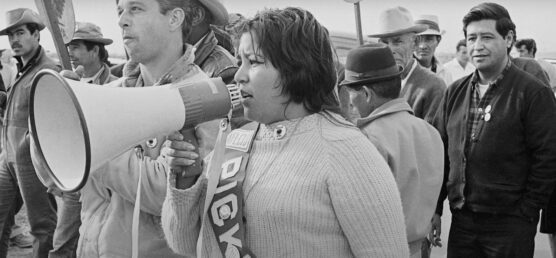They were the foot soldiers in the early days of the United Farm Workers, then known as the National Farm Workers Association. Their actions laid the foundation for much of the Chicano movement of the 1960s and ‘70s.
The oral histories 0f Bobby de la Cruz, Carmen Hernández, María and Antonia Saludado, Jose Serda and Richard Chávez were collected decades ago and are part of the archives of California State University, Northridge’s Tom & Ethel Bradley Center. Those very personal stories have been turned into dramatizations by CSUN students available on YouTube for a new generation to learn from.
“The intention is to highlight some of the people whose stories are not traditionally told,” said journalism professor José Luis Benavides, director of the Bradley Center, which is housed in CSUN’s University Library. “We know the stories of people like César Chávez and Dolores Huerta, but it isn’t very often that we hear the stories of those on the ground who did so much of the work. These stories are very moving and are the personal histories of people who did not know the impact they had.

Theater student Alejandra Guzmán as Carmen Hernández.
“It was key for us to make sure that people realized that El Movimiento (the Chicano Movement) was possible because of people like the ones whose oral histories we shared, not necessarily because of the leadership alone,” he said.
Many of the oral histories were taken nearly 30 years ago when CSUN hosted a conference for the union’s early organizers. Dozens of those organizers were interviewed about their lives and the union’s early days. Many of the oral histories, some hours long, were on tape and are not yet transcribed, while others have only been partially transcribed.
In choosing which oral histories to tell, Benavides and theater lecturer Doug Kaback looked for stories they thought would resonate with young people.
“We wanted to hear stories that reflected the stories of young people right now, and would be impactful when read by our students,” Benavides said.
Kaback said adapting oral histories “is tricky.”
“But we had an important objective—creating accessibility to these incredible stories of ordinary people who introduced El Movimiento and dedicated themselves to la causa,” Kaback said. “The goal was to take this raw material—the oral histories—and create something that could live on the Bradley Center website and elsewhere that could be watched by young and old alike.”
Benavides and Kaback selected a handful of the oral histories to be dramatized: de la Cruz, who, with his mother, were organizers during the union’s early days; Hernández, whose parents were active in the union and who later ended up working for the UFW; the Saludado sisters, who organized farmworkers during the union first major strike; Serda, who worked from the inside to organize workers; and Chávez, César’s brother.

Theater student Jesús Venegas Vázquez as Bobby de la Cruz.
Kaback adapted their stories into a dramatization that was read by CSUN theater students Eileen Ávalos as Antonia Saludado; Nicolás Guerrero as Richard Chávez; Alejandra Guzmán as Carmen Hernández; Ruby Hernández as María Saludado; Aldeir Vázquez as Jose Serda; and Jesús Venegas Vázquez as Bobby de la Cruz.
The performances were captured and edited by a team of multimedia students from CSUN’s IntersectLA, a student-run creative services and strategy agency, and overseen by art professor Joe Bautista. Marta Valier, a researcher in the Bradley Center, curated photographs, taken by Emmon Clarke and John Kouns, from the center’s Farmworker Movement Collection to serve as backdrops to the stories being told. Clarke and Kouns were among the only professional photographers to captured the union’s early days.
What the CSUN team created is a three-part series, “CSUN Farmworker Oral History Dramatization,” on YouTube that chronicles the experiences of de la Cruz, Carmen Hernández, the Saludado sisters, Serda and Richard Chávez as they initially joined the union, became organizers and the work they did during the union’s grape boycott, which took 58 months to resolve.
“It has been very creatively motivating to work on this because of the creative liberties and the incredible weight of the subject,” said cinema and television arts student Josh Mortenson, who edited the videos. “I’m so grateful that I was able to help in these stories.”

Theater students Ruby Hernández as María Saludado, left and Eileen Ávalos as Antonia Saludado.
Benavides and Kaback said they hope the videos draw attention to the real lives of the people involved in the early days of the farmworkers’ movement in a way that makes the history relevant to today’s generation.
“Hopefully, we touched people’s emotions,” Benavides said. “It’s emotions that really drive people’s interest in something. Hopefully, we’ve drawn their interest in this important part of our history.”
The Tom & Ethel Bradley Center’s archives contain over one million images from Los Angeles-based freelance and independent photographers between the 1930s to the present. The core of the center’s archive is a large collection of photographs produced by African-American photojournalists. Oral histories, manuscripts and other ephemeral materials support the photographic collection.
The archives contain more than 70 oral histories from African American photographers, civil rights leaders and organizers, individuals involved with the history of Los Angeles, journalism, the group Mexicans in Exile and the United Farm Workers, as well as the personal papers of many individuals and organizations. The center’s Border Studies Collection examines the issues surrounding the border between the United States and Mexico.
To view the film on YouTube, click [here].
Like this:
Like Loading...
Related





 Tweet This
Tweet This Facebook
Facebook Digg This
Digg This Bookmark
Bookmark Stumble
Stumble RSS
RSS































REAL NAMES ONLY: All posters must use their real individual or business name. This applies equally to Twitter account holders who use a nickname.
0 Comments
You can be the first one to leave a comment.